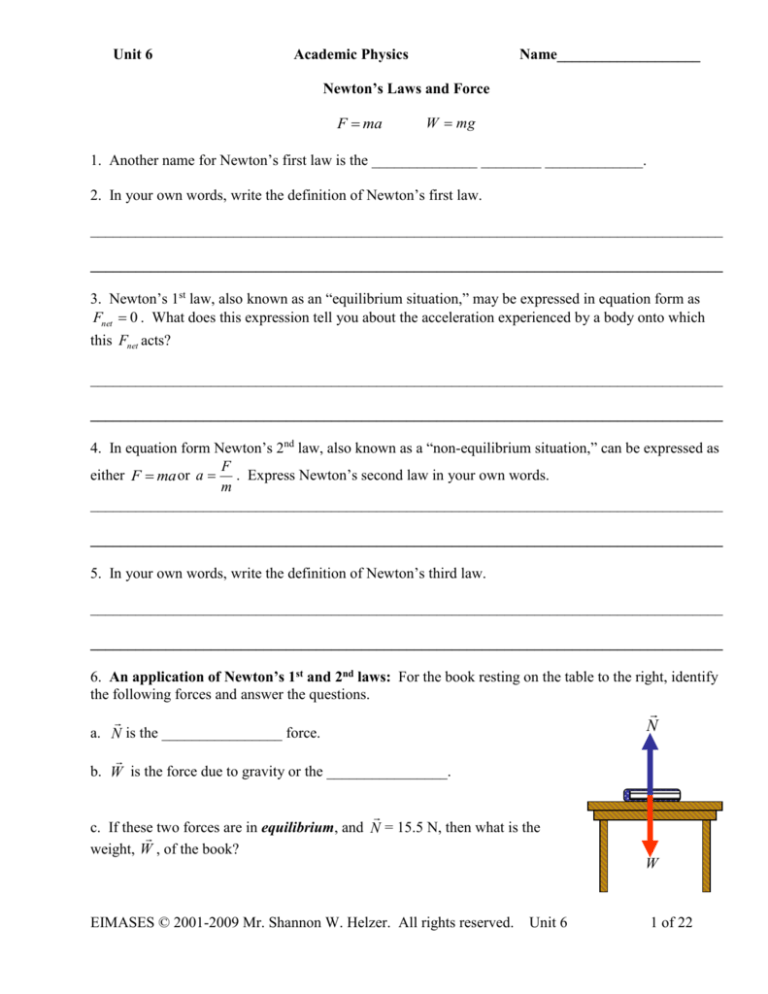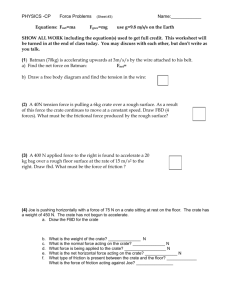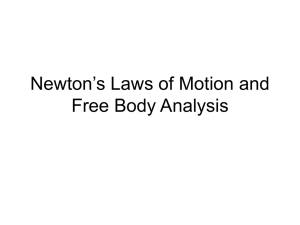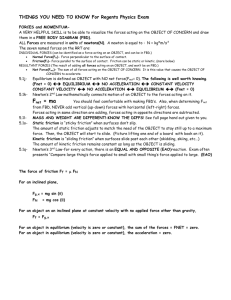
Unit 6
Academic Physics
Name___________________
Newton’s Laws and Force
F ma
W mg
1. Another name for Newton’s first law is the ______________ ________ _____________.
2. In your own words, write the definition of Newton’s first law.
____________________________________________________________________________________
____________________________________________________________________________________
3. Newton’s 1st law, also known as an “equilibrium situation,” may be expressed in equation form as
Fnet 0 . What does this expression tell you about the acceleration experienced by a body onto which
this Fnet acts?
____________________________________________________________________________________
____________________________________________________________________________________
4. In equation form Newton’s 2nd law, also known as a “non-equilibrium situation,” can be expressed as
F
either F ma or a . Express Newton’s second law in your own words.
m
____________________________________________________________________________________
____________________________________________________________________________________
5. In your own words, write the definition of Newton’s third law.
____________________________________________________________________________________
____________________________________________________________________________________
6. An application of Newton’s 1st and 2nd laws: For the book resting on the table to the right, identify
the following forces and answer the questions.
N
a. N is the ________________ force.
b. W is the force due to gravity or the ________________.
c. If these two forces are in equilibrium, and N = 15.5 N, then what is the
weight, W , of the book?
W
EIMASES © 2001-2009 Mr. Shannon W. Helzer. All rights reserved.
Unit 6
1 of 22
d. Now suppose a second force was added in the upward direction with N making the net force equal
to 25.0 N. What would happen to the book?
____________________________________________________________________________________
____________________________________________________________________________________
____________________________________________________________________________________
e. Part C describes an equilibrium situation. What is an “equilibrium” situation?
____________________________________________________________________________________
____________________________________________________________________________________
f. What is an non-equilibrium situation?
____________________________________________________________________________________
____________________________________________________________________________________
7. Two bulldozers are pulling on a crate as shown. Answer the questions below based of the figure
above.
a. If the right dozer is applying a force of 23,000.0 N to the right, then what force (magnitude and
direction) must the left dozer apply in order to maintain equilibrium? Explain your answer.
____________________________________________________________________________________
b. Now suppose the right dozer pulls with twice as much force as the left dozer. What type of situation
is this? Explain your answer.
___________________________________________________________________________________
8. ___________________ is the quantity of matter an object possesses.
9. ___________________ is the force acting on a body due to the presence of gravity.
10. The force due to gravity may be calculated from the following equation:
w mg
Where w is the weight, m is the _____________________, and g is the value of gravity that has a value
of ___________ in the metric system.
EIMASES © 2001-2009 Mr. Shannon W. Helzer. All rights reserved.
Unit 6
2 of 22
Free Body Diagrams (FBD)
F ma
W mg
For the figures below, the weight has a mass of 2.8 kg. Answer the following questions in regard to the
figures.
11. Draw and label the FBD for the picture to the left.
T1
12. What is the weight of the mass?
Weight
13. For the picture to the above left, what is the tension, T1, in the string? Explain your answer.
______________________________________________________________________________
______________________________________________________________________________
14. Draw and label the FBD for the mass to the left.
T1 T2
Weight
15. For the picture to the left, what are the tensions, T1 and T2, in the strings? Explain your answer.
______________________________________________________________________________
______________________________________________________________________________
EIMASES © 2001-2009 Mr. Shannon W. Helzer. All rights reserved.
Unit 6
3 of 22
The two weights shown on the pulley system to the right are 4.5 kg and
9.0 kg. Show your work.
2m
16. What is the weight of the 4.5 kg mass?
h
17. What is the weight of the 9.0 kg mass?
m
18. Draw and label the FBDs for the masses above.
m
B1
2m
B2
19. Two bulldozers, B1 and B2, pull on a crate as shown. Draw and label the free body diagrams for
the crate and determine the net force (magnitude & direction) and acceleration acting on the crate (m =
100.0 kg). B1 pulls to the left with a force of 15.0 N and B2 pulls to the right with a force of 7.0 N.
EIMASES © 2001-2009 Mr. Shannon W. Helzer. All rights reserved.
Unit 6
4 of 22
B1
B2
20. Two bulldozers, B1 and B2, push on a crate as shown. Draw and label the free body diagrams for
the crate and determine the net force (magnitude & direction) and acceleration acting on the crate (m =
100.0 kg). B1 pushes with a force of 9.5 N to the right and B2 pushes with a force of 11.2 N to the left.
21. Friction always acts in the _______________________ direction as the motion (or desired motion)
of a body.
22. A mass rests on an inclined plane as shown. It is sliding
down the plane in the direction indicated. Draw an arrow
representing the force of friction and the normal force
experienced by this mass. Explain your reasoning for
drawing this arrow.
_____________________________________________
_____________________________________________
What type of friction is depicted by the figure above? ______________________________________
23. Now consider the same weight except now it is at rest on
the inclined plane. Draw an arrow representing the force of
friction and the normal force experienced by this mass.
Explain your reasoning for drawing this arrow.
_____________________________________________
_____________________________________________
What type of friction is depicted by the figure above? ______________________________________
EIMASES © 2001-2009 Mr. Shannon W. Helzer. All rights reserved.
Unit 6
5 of 22
Two bull dozers are moving a crate as shown. The right bulldozer is pulling with a force F2 = 10,000 N
and the left bulldozer is pushing with a force of F1 = 6,000 N. Additionally, the force of friction
experienced by the crate is FF = 4,500 N. The mass of the crate is 1000 kg.
24. Draw and label the FBD for this crate.
25. Determine the net force acting on the crate above.
26. Determine the acceleration acting on the crate above.
A tractor initially at rest applies a force, FT, of 2300.0
N on the plow as shown. The plow pulls back on the
tractor with a force, FP, of 2000.0 N. Answer the
questions below in regards to this scenario. The mass
of the tractor is 5000 kg.
27. Draw the Free Body Diagram (FBD) of all the forces acting on the tractor.
28. What is the net force, FNET, acting on the tractor?
29. What is the acceleration experienced by the tractor?
EIMASES © 2001-2009 Mr. Shannon W. Helzer. All rights reserved.
Unit 6
6 of 22
Free Body Diagrams (FBD), Force, and Kinematics
F ma
W mg
30. For the triangle below, find sides Fy and Fx given:
a. = 61 and side F1 = 15.0 N.
b. = 180 and side F2 = 98.6 N.
c. = 289 and side F3 = 2533.6 N.
F
Fy
Fx
Vector Magnitude
F1
F2
F3
Angle
Fx
Fy
31. For the triangle above in problem 1, find sides Fy and Fx given:
a. = 89.2 and side F1 = 18.0 N.
b. = 122.8 and side F2 = 72.6 N.
c. = 189 and side F3 = 33.6 N.
Vector Magnitude
F1
F2
F3
Angle
Fx
Fy
EIMASES © 2001-2009 Mr. Shannon W. Helzer. All rights reserved.
Unit 6
7 of 22
32. A 0.155 kg baseball traveling at 52.8 m/s is caught in a catcher’s mitt. The mitt recoils by 0.135 m .
What is the average force exerted by the ball onto the mitt?
Variable Know Want
a
v1
v2
d1
d2
t
v2 v1 at
v2 v1 2ad 2 d1
1
d 2 d1 v1t at 2
2
2
2
33. What average force is needed to accelerate a 7.0 g bullet from rest to 192.0 m/s while it exits a 82.0
cm long rifle barrel?
Variable Know Want
a
v1
v2
d1
d2
t
v2 v1 at
v2 v1 2ad 2 d1
1
d 2 d1 v1t at 2
2
2
2
EIMASES © 2001-2009 Mr. Shannon W. Helzer. All rights reserved.
Unit 6
8 of 22
34. You are sitting in your chair at rest.
What forces are acting on you in your seat? Hint: There are two.
_________________________________________________________
Draw a FBD showing all the forces acting on you.
35. You are sitting in your chair and Sheena is pulling you to the right.
If Sheena is pulling you to the right, then in which way does the force
of friction act? _______________________________________________
What other forces are acting on you in your seat?
_________________________________________________________
Draw a FBD showing all the forces acting on you.
36. An air hockey puck is sliding across an air hockey table (assume that there
is no friction).
What other forces are acting on the puck?
_________________________________________________________
Draw a FBD showing all the forces acting on the puck.
37. A granite block and a weight are connected as shown in the figure below. The weight is
descending. Draw and label the FBDs for the weight and the block.
What are the forces acting on the block?
_________________________________________________________
What are the forces acting on the weight?
_________________________________________________________
EIMASES © 2001-2009 Mr. Shannon W. Helzer. All rights reserved.
Unit 6
9 of 22
38. A train passenger car has lost a set of wheels and two engines are trying to pull it back to the station.
The engine to the right is pulling the passenger car with a force of FR = 12,000 N to the right.
Unfortunately, the engineer in the train on the left thought that they were supposed to go in the other
direction. He is pulling the passenger car with a force of FL = 7,500 N to the left. Additionally, the
force of friction generated by the dragging passenger car is FF = 2,500 N. Answer the questions below
in regards to this scenario. The mass of the passenger car is 1000 kg.
a. Draw the FBD for the passenger car. Explain why you positioned the force of friction, FF, in the way
you did in the FBD.
___________________________________________________
___________________________________________________
b. Determine the net force, FNET, and the acceleration experienced by the passenger car.
EIMASES © 2001-2009 Mr. Shannon W. Helzer. All rights reserved.
Unit 6
10 of 22
Free Body Diagrams (FBD), Force, and Kinematics
F ma
W mg
Fk k N
Fs s N
39. A 60.0 kg boy and a 40.0 kg dog are engaged in a game of tug-of-war on an icy surface (assume
there is no friction). If the dog experiences an acceleration of
2.8 m/s2 towards the boy, then what is the boy’s acceleration
towards the dog? Draw the Free Body Diagrams (FBDs) for
the dog and the boy. (Hint: Newton’s 3rd law.)
40. A force of 29.2 N is applied to a 13.8 kg box. The box slides across the floor at a constant velocity.
What is the coefficient of kinetic (sliding) friction between the floor and the box?
What type of a situation is this?
_________________________________________________________
Fa
Draw the FBD for the box.
EIMASES © 2001-2009 Mr. Shannon W. Helzer. All rights reserved.
Unit 6
11 of 22
41. A fisherman catches a fish of mass 2.1 kg. The fishing line can withstand a maximum of 38.9 N of
tension before breaking. At one point while reeling in the fish, the fish exerts a force of 40.2 N. With
what minimum acceleration must you “play out” the line during this exertion in order to avoid
surpassing the maximum allowable tension in the line?
Start by drawing the FBDs for the fish and the fishing rod.
42. A 97.8 kg sled is pulled across a snow covered lake.
s = 0.28 and k = 0.12.
a.
b.
c.
d.
How much does the sled weigh?
What force is necessary to start the sled moving (find the maximum force of static friction)?
What force is needed to keep the sled moving at a constant velocity?
Suppose we wanted to accelerate the sled to 3.6 m/s2 to the left. How large of a force would we
need to apply to the sled?
EIMASES © 2001-2009 Mr. Shannon W. Helzer. All rights reserved.
Unit 6
12 of 22
43. A force of 52.8 N is applied to a 21.2 kg box accelerating at 2.2
m/s2.
Fa
What type of a situation is this?
_______________________________________________________
a. Calculate the force of Friction.
b. Calculate the coefficient of kinetic friction
44. The Atwood’s Machine. A 20.2 kg mass (m2) and an 11.9 kg mass (m1)
are attached by a string that passes through a pulley as shown. Initially m1 is
held then released.
a. In which direction will m1 accelerate when released? Up or Down
b. In which direction will m2 accelerate when released? Up or Down
c. Draw the FBDs for the two masses.
m2
m1
d. Find the tension (T) in the string and the acceleration (a) experienced by the masses.
EIMASES © 2001-2009 Mr. Shannon W. Helzer. All rights reserved.
Unit 6
13 of 22
45. The figure to the left shows a table with a crate on it. The crate is
attached to two masses. The large mass (left side) is 2.0 kg and the small
mass (right side) is 1.0 kg. In addition to the forces generated on the
crate by the masses, the force of friction has a magnitude of 4.8 N.
Answer the questions below in regards of this figure.
a. Draw and Label the FBDs (Free Body Diagrams) for the right weight,
the crate, and the left weight. Label the force due to the right mass as FR
and the force due to the left mass as FL.
b. Calculate the forces, FR and FL, acting on the crate. (Hint: these forces are equal but opposite to the
weights of the masses.)
c. Calculate the acceleration experienced by the crate as a result of all the forces acting upon it.
Left Weight
Crate
EIMASES © 2001-2009 Mr. Shannon W. Helzer. All rights reserved.
Right Weight
Unit 6
14 of 22
46. Evil Snowbell has plotted to be rid of Stewart Little once and
forever. The sinister cat tied Stewart’s car to a mass and allowed it to
dangle as shown. In between the pulley and Stewart’s car, Snowbell
has placed a rat trap. The mass of the mass is 5.5 kg. Stewart’s car
can generate a maximum of 60.0 N of force. While struggling to save
himself, Stewart experiences a friction force, FF, of 3.8 N. Answer the questions below.
a. Draw the FBD (Free Body Diagram) for the weight and for Stewart Little’s car. Label the force due
to the mass as Fm.
b. What is the net force acting on Stewart’s car?
c. What is the acceleration acting on Stewart’s car?
Weight
Mouse
d. Based on your answers in part b and c, will Stewart survive? Explain your answer.
____________________________________________________________________________________
____________________________________________________________________________________
____________________________________________________________________________________
____________________________________________________________________________________
EIMASES © 2001-2009 Mr. Shannon W. Helzer. All rights reserved.
Unit 6
15 of 22
Unit 6 Exam Review: Newton’s Laws, Friction, Equilibrium, and Acceleration
47. A boat is propelled through a rapidly flowing stream with a force of 2,258.0 N. It experiences an
opposition force of 1,892.8 N due to the current of the stream.
Fo
Fp
a. If the boat and passenger combined have a mass of 1,288.0 kg, then what is the acceleration of
the boat through the water? (a = 0.28 m/s2)
b. If the boat started from rest, then calculate how far it will go in 22.8 s. (d2 = 72.7 m)
c. What will the boat’s velocity be after 22.8 s? (v2 = 6.4 m/s)
Variable
a
v1
v2
d1
d2
t
Know
v2 v1 at
v2 v1 2ad 2 d1
1
d 2 d1 v1t at 2
2
W mg
FF k N
FF s N
2
2
EIMASES © 2001-2009 Mr. Shannon W. Helzer. All rights reserved.
Unit 6
16 of 22
48. Two forces are applied to a crate as shown above. The crate is resting on the ground. k = 0.21 and
s = 0.26. The mass of the crate is 48.2 kg.
In which direction will the box slide?
Right
Left
What type of a situation is this? _________________________________________________________
What other force is acting in the horizontal direction in addition to F1 and F2?
In which direction is it acting?
Right
Left
Draw the FBD for the box.
What is the acceleration of the box? (a = -1.23 m/s2)
EIMASES © 2001-2009 Mr. Shannon W. Helzer. All rights reserved.
Unit 6
17 of 22
49. A 42.9 kg weight is suspended by a string attached to a
13.5 kg box. The coefficient of kinetic friction (k) between
the box and the table is 0.135.
mb
a. Draw the FBDs for both the weight and the block.
mw
b. What are the tension and the acceleration of the system? (Hint: you must use Newton’s laws in the x
and y directions in order to write two equations with two unknowns.) (T = 114.114 N and a = 7.14 m/s2)
EIMASES © 2001-2009 Mr. Shannon W. Helzer. All rights reserved.
Unit 6
18 of 22
50. The Atwood’s Machine. A 34.2 kg mass (m2) and a 19.9 kg mass (m1) are
attached by a string that passes through a pulley as shown. Initially m1 is held
then released.
d. In which direction will m1 accelerate when released? Up or Down
e. In which direction will m2 accelerate when released? Up or Down
m2
f. Draw the FBDs for the two masses.
m1
d. Find the tension (T) in the string and the acceleration (a) experienced by the masses. (Hint: you must
use Newton’s laws in the y direction for both masses in order to write two equations with two
unknowns.) (T = 246.56 N and a = 2.59 m/s2)
EIMASES © 2001-2009 Mr. Shannon W. Helzer. All rights reserved.
Unit 6
19 of 22
Unit 6 Substitute Worksheet: Free Body Diagrams and Kinematics
51. A helicopter’s engine exerts a force of 23,500.0 N to the left. A head
wind exerts a force of 9,500.0 N to the right on the helicopter. What is the
acceleration acting on the helicopter? The mass of the helicopter is 7500.0
kg.
52. If the helicopter was initially traveling at 25.0 m/s, then how fast is it going and how far did it go in
3.0 minutes?
Variable
a
v1
v2
d1
d2
t
Know
v2 v1 at
v2 v1 2ad 2 d1
1
d 2 d1 v1t at 2
2
W mg
FF k N
FF s N
2
2
EIMASES © 2001-2009 Mr. Shannon W. Helzer. All rights reserved.
Unit 6
20 of 22
53. Draw the free body diagram of the block
resting on the inclined plane to the right.
Locate your Unit 5 lab on friction. Review this lab in order to help you answer question number 4.
54. The graph to the right is of friction v.
time as a book is pulled by a gradually
increasing force.
b. Label the part of this graph that
corresponds to kinetic friction.
1
0
-1 0
Friction (N)
a. Label the part of this graph that
corresponds to static friction.
Force of Friction v. Time
2
4
6
8
10
-2
-3
-4
-5
c. Label the part of this graph that
corresponds to the point where the books
first began to move.
-6
-7
EIMASES © 2001-2009 Mr. Shannon W. Helzer. All rights reserved.
Time (s)
Unit 6
21 of 22
*** Giancoli Physics Homework Assignment ***
Read Chapter 4 Sections 1 – 6 and 8
Answer Conceptual Questions (Page 97) 1, 2, 6, and 13
Do Problems (Page 98) 7, 19, and 34.
Chapter Vocabulary
1. Force –
2. Inertia –
3. Newton [N] –
4. Weight –
5. Normal Force –
6. Net Force –
7. Free Body Diagram –
8. Tension –
9. Static Friction –
10. Kinetic Friction –
EIMASES © 2001-2009 Mr. Shannon W. Helzer. All rights reserved.
Unit 6
22 of 22








